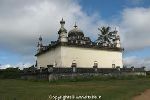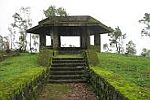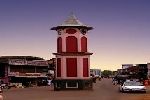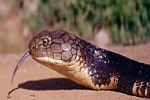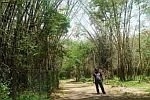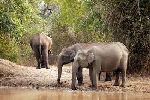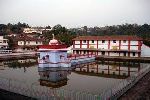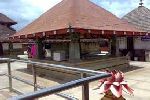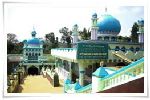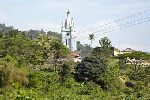Talakaveri
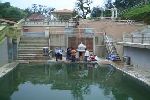
Talakaveri, rested atop the Brahmagiri Hill adjoining Bhagamandala approximately 43 kilometers away from Madikeri is a 'Kundike' i.e. water tank from where the holy River Kaveri (Cauvery) is believed to be originating. However, to the surprise of the tourists, no undying water flow is evident from this spot, except for the monsoon season. The devotees hold a belief that a tiny perpetual spring initiates from here, flows below the ground indiscernibly and later comes into sight at the little distance aloof. According to the Hindu scriptures, the river Cauvery is venerated as one of the 'Sapta Sindhus' i.e. the seven sacred rivers. A small shrine devoted to Goddess Kaveriamma and two sub shrines dedicated to Lord Shiva and Lord Ganesha can be spotted in the propinquity with Talakaveri. The Talakaveri Kundike is also referred to as 'Tirtha Kundike' or 'Brahma Kundike' amongst the locals as the water surging from this tarn is supposed to be sin cleansing and purifying. Pilgrims regularly pay a visit to Talakaveri and bathe in the sanctified and 'moksha giving' waters of this Tirtha. As per the prevailing legend, when the Hindu Trinity viz. Brahma, Vishnu and Mahesh along with Lord Ganesha had materialized before a righteous sage named Agastya, the river Kaveri emerged out of the Kamandalu of the sage and started flowing onto the earth. Thousands of devotees congregate at Talakaveri on the auspicious occasion of 'Tulasankramana' which falls in the month of October and worship the holy water spring that gushes out of the 'Talakaveri Kundike'. It is believed that at this time of the year Goddess Parvati; the consort of Lord Shiva arrives at Talakaveri and Kaveri starts flowing in profusion to pay respect to the Mother Goddess Parvati. 'Tula Snanam' (a ceremonial holy bath) is observed both at Talakaveri and also on the banks of the river Cauvery on the day of Tulasankramana. A climb of about 365 steps from Talakaveri will reach you to the Brahmagiri Peak from where superlative prospects of the surrounding countryside and the majestic Mangalore Sea can be perceived.
Nisargadhama
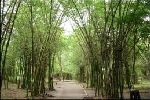
Positioned about 3 kilometers away from Kushalanagara and located at the distance of nearly 30 kilometers from Madikeri Nisargadhama is an island in the Kodagu District that is formed by the River Kaveri. Renowned all over the Karnataka as a well-liked picnic destination and a popular holiday retreat, Nisargadhama Island is a favorite hangout junction both amongst the locals as well as the tourists. Covering an extensive area of about 64 acres and confined by the Kaveri River on all its sides, this dandy atoll is brimming with the dense foliage of bamboo groves and teak and sandalwood trees. To access the Nisargadhama Island one will have to cross the hanging rope bridge that has been installed here. Some of the not to miss attractions of the Nisargadhama Island comprise, the Rabbit Park, Deer Park, Peacock Park, Orchidarium, Elephant Ride, Boating in the Kaveri River, White Water Rafting and a playground specially laid for the kids. At several spots where the water is not too deep, the tourists are even allowed to go into the riverbed and enjoy bathing. At Nisargadhama a guest house run by the forest department and some treetop bamboo cottages are available where on prior reservation tourists can spend night in the cradle of the pristine nature. Unwinding and relaxing in the vicinity of the composed and unruffled beauty of Nisargadhama is unquestionably an experience to be remembered for the lifetime.
Abbey Falls
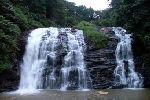
The Abbey Falls, to be found amidst the Western Ghat Mountain Ranges about 8 kilometers away from Madikeri is a dazzling water cataract that descends from the lofty pinnacles into the River Kaveri. Manifold water rivulets overflowing due to the torrential rains tumble down the hilly slopes of the Western Ghats at a great speed and toppling against the huge boulders make their way through the ravines and chasms. All these brooks combine close to Madikeri and form the grandiose Abbey Falls. The cascade is flooding with overabundance of water during the rainy season and in summer as well, though relatively condensed than monsoon the waterfalls are teeming with bounteous water. The Abbey Falls flow in the midst of the private spice and coffee estates around Madikeri. The slender path that leads to the Abbey Falls passes through the aromatic coffee and cardamom plantations and even walking within these cultivated areas is a heavenly experience. The uproars of the cascade are audible even from the main road and as you follow the trail of the noise through the spice farms, the cataract will abruptly appear before you. The sparkling silvery water gushing down with enormous momentum against the backdrop of the verdurous woods of the Western Ghats and descending over the huge rocks into the serene pools is definitely an awe-inspiring panorama. The melodious twittering of the birds yields seraphic background music to the deafening roars of the Abbey Falls. A hanging bridge is built right in front of the cascade which can be used to reach the Abbey Falls. Additionally, a small temple dedicated to Goddess Kali is also set up adjacent the waterfall. It is to be noted that bathing at the Abbey Falls is not allowed as the water surges into steep rocky valley here and what is more, oodles of leeches are also found inside the water. Post monsoon and early winter is the most suitable time for visiting this wonder of nature.
Iruppu Falls
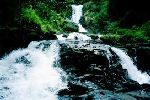
Placed within the Brahmagiri Ranges about 75 kilometers away from Madikeri, the Iruppu Falls also widely recognized by the name 'Lakshmana Tirtha Falls' are fresh water cataracts proliferating in the Kodagu District. The subsidiary title of the Iruppu Falls has been coined from the name of the Lakshmana Tirtha River; the tributary of the river Kaveri that originates from this very waterfalls. As per the prevalent myth, Lord Ram during his quest of Devi Sita had traversed along the Brahmagiri Ranges with his brother Lakshmana. When Lord Ram felt thirsty and asked for the drinking water from Lakshmana, he shot an arrow into the Brahmagiri and from there the Lakshmana Tirtha River emerged. On account of this mythological parable, the Iruppu Falls are believed to hold the sin refining powers. Thousands of pilgrims alight at the Iruppu Falls on the propitious day of Maha Shivaratri and take a holy dip into the divine waters of the Lakshmana Tirtha River. A trail from the Brahmagiri Peak will reach you to the Iruppu Falls where you can witness the 170 feet tall drop of the milky white water. A small temple dedicated to Lord Shiva is parked on the banks of the river Lakshmana Tirtha close to the root of the Iruppu Falls. Celebrated both as a supreme tourist attraction and a hallowed pilgrim destination, the Iruppu Falls receive a deluge of devotees particularly at the time of the Maha Shivaratri Festival. Nonetheless, the most ideal season to pay a visit to the Iruppu Falls is monsoon when this chute is brimming with abundant water and the adjoining terrain is also flourishing with fresh bright foliage.
Mallalli Falls
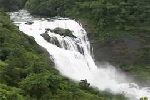
The Mallalli Falls sited at the foothills of the Pushpagiri Peak of Kumarparvata at the approximate distance of 25 kilometers from Somwarpet near the Bettadahalli Gram Panchayat is yet another stunning water cascade that adds to the celestial regalia of this 'Kashmir of South'. Distinguished as one of the most charismatic waterfalls of the Coorg region, the Mallalli Falls originate at the place where the Kumaradhara River takes a rapid drop of over 200 feet. Beholding the grand course of the Kumaradhara River rolling through the lush green Kumarparvata Valley into a luxuriant abyss is undeniably an extravagant feast for the human sight. Monsoon is the perfect and most idyllic season for visiting the Mallalli Falls when the water cascade filled with water in profusion first soars high and then gushes down with supreme velocity.
Chelavara Falls
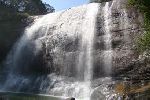
The Chelavara Falls based in the proximity with a small village named Cheyyendane about 26 kilometers away from Madikeri is another captivating water cataract to be found around Coorg. Stationed in the middle of the odorous coffee plantations of Kodagu, the Chelavara Falls are prevalently acknowledged amongst the natives by its nickname 'Embepare', which in the local vernacular means a 'Tortoise Rock'. Watching the water undulating through the rich coffee plantations is absolutely a breathtaking spectacle. The 'Choma Kund Hill' placed just two kilometers away is an additional tourist appeal near the Chelavara Falls. The Choma Kund encompassed with burgeoning vegetation and meticulously covered with fog most of the times yield an amazing panorama to be witnessed. In addition to that, the bonus that expressly beckons the visitors is the impressive glimpses of the fathomless Arabian Sea observed from the Choma Kund Hill.
Honnamana Kere
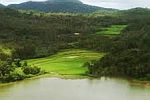
'Honnamana Kere' located at Doddamalthe abreast the Sulimalthe Village about 6 kilometers away from Somwarpet is a scintillating lake of Coorg that is honored to be the largest water reservoir of the Kodagu District. Highly revered as a sacred water pool by the natives, the Honnamana Kere boasts of the interesting mythological anecdote it bears at its background. The legend goes that certain Goddess named Honnama gave up her life here for the safety and welfare of the people. A small temple dedicated to the Goddess Honnama has been established on the banks of the sanctified Honnamana Kere Lake and on the occasion of the 'Gowri Festival' a special pooja is offered to the Goddess every year. Moreover, the 'Bagina' which includes the belongings of Goddess Honnama is also offered to the heavenly lake. On this day thousands of devotees of Goddess Honnama assemble at the Honnamana Kere and pay homage at the Honnama Temple. Bounded by imperial mountain ranges, ostentatious cliffs and blooming coffee plantations, the Honnamana Kere tenders a bravura spectacle to its guests. A new temple was erected here some years back in order to develop this place as a pilgrim destination near Coorg.
Raja's Seat
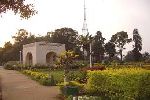
Raja's Seat, acclaimed as one of the most sought after tourist spots near Madikeri in the Kodagu District is a seasonal garden teeming with plentiful flowers and studded with several artificial fountains. The phrase 'Raja's Seat' literally means 'the seat of the king'. The spell binding verdure, the theatrical series of tall and short mountains wrapped in mist and the entrancing panoramas of the sun setting against the vivid scrim of the azure sky absolutely mesmerize the visitors of Raja's Seat. This locale receives its title from the popular belief that in olden days the kings of Kodagu accompanied by their queens used to spend romantic evenings in this garden enjoying the beguiling vistas of the setting sun. A small square construction of four pillars attached by four arches and built in brick and mortar is parked in the middle of the garden amidst the pulchritudinous milieu. This is the charming spot where the Rajas must be indulging in leisure and recreation. Raised on an elevated platform this square offers the arresting outlooks of the cliffs and valleys to the west of the Raja's Seat. The best time to visit this splendid garden is either early morning or in the evening. At the daybreak, the juvenile rays of the sun penetrate the veil of the mist put on by the gorge beneath and illuminate the entire landscape. While in the evening the diminishing aura of the setting sun performs golden jazz of colors on the dais of the firmament. However, sometimes due to clouds, this brilliant pageant of colors at sunset or sunrise is not discernible. Besides, the Toy Train installed at the Raja's Seat turns out to be an inevitable magnetism for the children coming here. Only 5 INR are charged here as the entry fee. Do not forget to savor the mouth watering bhelpuri and other Indian chat as you visit the Raja's Seat Garden of Coorg.
Bhagamandala
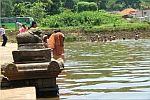
Bhagamandala located about 39 kilometers away from Madikeri and just 8 kilometers away from Talakaveri is a greatly cherished pilgrim destination of the state of Karnataka where three holy rivers namely Kaveri, Kannike and Sujyoti converge. Highly venerated for its religious magnitude of being a 'Triveni Sangama' (the confluence of three rivers), Bhagamandala receives hordes of devotees on the felicitous occasion of 'Tula Sankramana' when devotees flock here in large numbers and immerse themselves in the 'sin erasing' Triveni Sangama waters. Adding to that, Bhagamandala is also famed in all quarters as the sacred berth where post demise rituals are performed in the honor of the departed ancestors. A well-known temple of 'Sri Bhagandeshwara' dedicated to Lord Subramanya, Lord Mahavishnu and Lord Ganapati is sited close to the Triveni Sangama. It is believed that this ancient temple was established here by a sage named 'Bhagamandala' and the township receives its name after the well-regarded Bhagandeshwara Kshetra itself. The Bhagandeshwara Temple is designed in the Kerala style of temple architecture that reveals certain influences of the Nepali architectural order too. The wooden carvings spotted inside the temple are outstandingly commendable and utterly beyond compare. The idol of Lord Subramanya that is enshrined in the sanctum of the temple is assumed by the devotees to be 'Swayambhu' i.e. self originated. Free lunch is served to the pilgrims every day at the Bhagandeshwara Temple.
Dubare
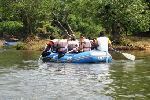
Dubare, positioned on the banks of the river Kaveri at Kushalanagar in Kodagu District is a famous forest elephant camp of Southern India, reckoned as a very important base for the elephants of the Forest Department of the state of Karnataka. Dubare Elephant Camp is the place where originally the elephants were trained for participating in the royal procession at the time of the Dussehra Festival of Mysore. At present the elephants trained at Dubare are mainly used for the joy rides of the visitors. The moist deciduous woods of Dubare provide a refuge to a number of wild animals and rare birds. Apart from the wild as well as tamed and trained Asiatic elephants, other animals and birds commonly spotted at Dubare are; spotted deer, sambhar, wild dogs, gaur, bears, tiger, leopard, crocodiles, venomous and non-venomous snakes, other reptiles, kingfisher, peacocks, woodpeckers, partridges, and so on. Nisargadhama, Veerabhoomi, Wildlife Safari, coracle ride and still water rafting are some other must not miss attractions of Dubare excluding the elephants training camp.
Bylakuppe

Stationed along the State Highway no 88 to the west of the Mysore District, Bylakuppe; a chain of twenty villages is the second largest Tibetan settlement existing outside Tibet. Established by Lugsum Samdupling and Dickyi Larsoe, this Buddhist Federation provides home to thousands of Tibetan refugees who found their way to India in 1960s subsequent to the Chinese Aggression and the Tibetan Uprising of 1959. Speckled with a number of Tibetan Buddhist monasteries, Bylakuppe is particularly distinguished for its Great Gompa of Sera Je, Namdroling Monastery, Sakya Monastery, Tashi Lunpho Monastery and Sera Mey. Additionally, Bylakuppe is also renowned for its Golden Temple, Ganapathi Temple, Rangaswamy Temple and the Ingalakere Lake. The Golden Temple is principally exalted for housing the pair of 40 Feet tall statues of Lord Buddha worshipped by the names Padmasambhava and Amitayus.
Thadiyandamol
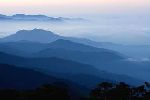
Located at the approximate distance of about 40 kilometers from Madikeri and nestled at the elevation of 5730 feet above the ground, Thadiyandamol happens to be the highest mountain peak of Kodagu District and the second highest crest in the entire Karnataka State. Quite popular amongst the mountaineers and the trekkers, the Thadiyandamol peak is indeed a paradise for the explorers and the adventure enthusiasts. The trekking trail inaugurates at the base camp of Thadiyandamol i.e. the Palace Estate and the experienced trekkers would easily conquer the summit just in 3 to 4 hours. It is to be noted that the route that leads to the apex is bursting with leeches and the trekkers are advised to go prepared to fight against them. Salt is the best remedy to kill the leeches.
Madikeri Fort
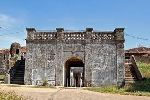
The Madikeri Fort haughtily standing right in the center of the Madikeri City is an ancient citadel originally built in later 17th century under the patronage of King Mudduraja of Haleri Dynasty; the prince who founded Madikeri in 1681 AD. Initially, the settlement was christened as 'Muddurajanakeri' by King Mudduraja however with the passage of time 'Muddurajanakeri' became 'Madikeri'. A palace was also constructed by the King Mudduraja inside the Madikeri Fort. Many years later, the original mud fortress was reconstructed in granite by Tipu Sultan who renamed Muddurajanakeri as 'Jaffarabad'. Again in 1790 the fort was taken over by Doddavira Rajendra and King Lingarajendra Wodeyar II refurbished the stronghold in 1812-1814. Finally in April 1834, the garrison was annexed to the British Empire. Majestically erected over an elevated portion of land and resembling the silhouette of a hilltop, the Madikeri Fort tenders an all-inclusive vision of the entire Madikeri Township. Two life sized masonry elephants installed at the entrance of the fort towards the north-east corner figuratively guard the gates. Six spherical bastions and three consecutive gates of the castle safeguard the main entrance of the Madikeri Fort. A Ganesha Temple, a chapel, the district prison and a small archaeological museum are also housed within the periphery of the fort. At present, this stronghold of Madikeri houses a number of governmental offices.
Nalknad Palace
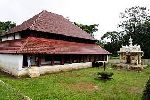
The Nalknad Palace placed at the foothills of the Thadiyandamol Hills close to the tiny hamlet of Kodagu District named Yavakapadi is an ancient regal alcazar built by Maharaja Dodda Veerarajendra; the Emperor of Kodagu in 1792 AD. This two storied structure topped with a tiled roof and a pointed dome is elaborately adorned with ornate wood carvings and extraordinary old paintings. Garlanded with a pillared frontage and decorated with the figurines of four bulls in its courtyard, this antique abode of the kings of Kodagu is undeniably an epitome of the architectural ingenuity accomplished by the artisans of the bygone eras. Nalknad Palace has been a witness to the second betrothal of King Dodda Veerarajendra and also the retreat of the last sovereign of Kodagu; King Chikka Veerarajendra. Later, Chikka Veerarajendra; the son of King Linga Rajendra was sent to Benares (Varanasi) by the British. In the present day, the Nalknad Palace is declared as the protected monument by the Directorate of Archaeology and Museums; Government of Karnataka. In recent times the Nalknad Palace was even revamped by INTACH at the expenses of over 2.29 million rupees. Currently a scheme has been proposed under which the palace will be converted into a museum where the models representing the art and craft of the Kodagu region will be displayed which will render this erstwhile palace a thriving tourism hub of Coorg. A Kannada movie named 'Shanti' was filmed around the Nalknad Palace which further added to the prominence and esteem of the Nalknad Palace.
Harangi Dam
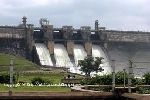
The Harangi Dam, commonly referred to as the 'Harangi Reservoir' is located adjoining the Hudgur Village of Somwarpet Taluk about 9 kilometers away from Kushalnagar Town in Coorg. Harangi River is the tributary of the Cauvery River and the Harangi Reservoir was formed by building a masonry dam across it. This dam receives the maximum number of tourists during the rainy season when it is swarming with water in galore. This taciturn place sited far away from the hustle bustle of busy city life and void of any commercialism at all is the ultimate potpourri of loveliness and quietude. Unwinding in the calm and composed ambience of Harangi Dam and feeling the fondling touch of the gentle breeze that kisses you with placid grace is indeed a worth craving for experience. On average, only a restricted number of tourists visit this reservoir. Guest Houses are also made available on the brink of the Harangi Dam where visitors can spend night in the intimacy with plethora of water and pristine natural glamour. One can get a booking for this Guest House from the public works department. It is to be noted that if you are not planning to spend night at the Harangi Dam, make sure that you leave the premises before 6:00 pm as the whole complex gets closed after that.

